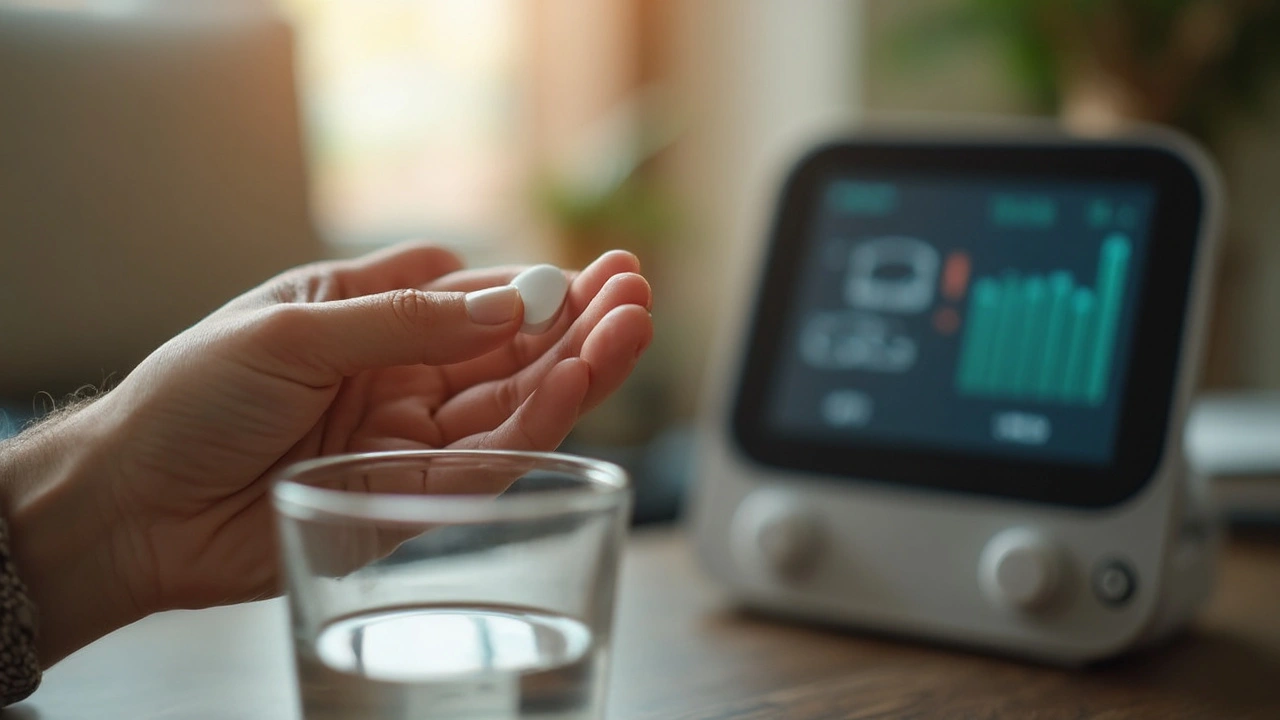If you’ve ever sat in a waiting room nervously eyeing that blood pressure cuff, you might’ve heard your doctor mention a strange-sounding pill: Coversyl. Officially known as perindopril, it’s a quiet superstar in the world of heart medications. More people than you’d think have this little tablet tucked into their medicine organizer, but there’s more to Coversyl than just being another script from the pharmacy. It’s got its quirks, benefits, side effects, and, honestly, a few surprises that most folks don’t find out about until after they start taking it. Wondering about whether it’s working for you or maybe if that odd dry cough is normal? You’re far from alone.
What is Coversyl and Why Is It Prescribed?
Coversyl (perindopril) isn’t exactly the new kid; it’s been around since the late 1980s and has built a solid track record. It belongs to a group called ACE inhibitors. The whole job of this class is to relax your blood vessels, making it easier for your heart to do its work without feeling squeezed like a stress ball. But Coversyl isn’t just about high blood pressure. It’s also handed out to tackle chronic heart failure and, for some, to protect the kidneys in people dealing with type 2 diabetes or chronic kidney disease.
You’re probably thinking, “So how does this pill actually make a difference?” By blocking the hormone that tightens blood vessels (angiotensin II), Coversyl helps widen them. This makes your heart's job simpler and helps lower that top-and-bottom number on the BP machine—not just once, but day after day. Doctors also lean on it after heart attacks. Real-world numbers show Coversyl can reduce the risk of stroke, heart attack, and death from heart disease, especially in people with previous heart problems. Studies in Australia, France, and the UK—all places where perindopril is prescribed miles and miles away from each other—found that people who stick with their medication and manage risk factors (like smoking or high cholesterol) generally fare better than those who don’t.
Still, just because it’s common doesn’t mean you should ever self-prescribe. Doctors typically start you on a low dose and work up, all while keeping an eagle eye on your kidneys and potassium levels. It’s not safe for everyone. Pregnant women, for instance, should absolutely avoid it, and it’s not a good match if you’ve ever had an allergic reaction to other ACE inhibitors. Even something as simple as dehydration or a recent episode of diarrhea can tip the scales and make taking Coversyl risky, because it can mess with your body’s salt balance.

Taking Coversyl: Dosage, Tips, and What to Watch Out For
Grabbing your tablet and swallowing isn’t the whole story. When your doctor scribbles down that Coversyl prescription, they’ll probably start with the lowest effective dose possible. For most adults with high blood pressure, that’s usually 4 mg once a day, sometimes bumped up to 8 mg as needed. With heart failure or people recovering from a heart attack, the dose starts even lower—just 2 mg a day, gradually increased without rushing it.
Here’s a hidden trick: it’s best to take Coversyl at the same time every morning before breakfast. Food can affect how your body soaks up the medicine, so consistency is key. This also helps you remember and weave the pill into your routine. Use a day-of-the-week pillbox if you’re likely to forget. Always have a backup supply; don’t wait until you’re down to your last tablet to refill the script. Unexpected things happen—holidays, pharmacy stock issues, even storms can delay your refill.
Coversyl shouldn’t be stopped suddenly. Missing doses or stopping on your own could send your blood pressure rocketing back up. If you forget a dose, take it as soon as you remember unless it’s almost time for the next; never double up. If you’re juggling other medications—especially diuretics (water pills), potassium supplements, NSAIDs like ibuprofen, or lithium—you need to check in with your doctor first. These combinations can spark some nasty interactions, like kidney problems or high potassium, and it’s way more common than you’d guess.
Wondering about side effects? The most talked-about is that dry, hacking cough—not dangerous, but it can get annoying enough for some to want to quit the medication. Other possible hiccups include dizziness (especially if you stand up quickly), headaches, tiredness, changes in taste (ever had food taste metallic for no good reason?), or actual swelling in your face or mouth. Potassium levels can sneak too high—easy fix with a blood test, but worth watching if you love bananas, oranges, or salt substitutes. Weirdly, your skin might even burn more easily in the sun, so slap on sunscreen if you’re headed outdoors.
If you’re pregnant, planning to be, or even think you could be, you absolutely can’t take Coversyl. It’s linked to serious birth defects and complications. And if you ever get swelling in your tongue or lips, rush to the hospital. That’s angioedema, a rare but severe allergic reaction. Keep a list of all medications handy—doctors will ask, and it could save time in emergencies.
Curious about how fast it works? Blood pressure can start dropping after a week, but the full benefits for heart protection build up gradually over months. Stick with it and don’t be discouraged if your numbers don’t look perfect right away.

Real-Life Facts, Extra Tips, and Monitoring Your Health
More than five million people globally are prescribed perindopril every year. It’s on the World Health Organization’s list of essential medicines, mainly because it’s proven, affordable, and generally well-tolerated so long as you keep tabs on bloodwork. For most users, sticking with routine checkups can catch hiccups before they turn into headaches—literally and figuratively.
Let’s break down some specifics in a table:
| Fact | Detail |
|---|---|
| Starting Dose (high blood pressure) | 4 mg once daily |
| Max Dose (high blood pressure) | 8 mg once daily |
| Common Side Effect | Dry cough (up to 20% of users) |
| Serious Risk | Angioedema (swelling, rare) |
| How Fast It Works | 1-2 weeks noticeable drop, max effect in 1 month |
| Pregnancy Safety | Not safe |
| Most important seo keyword | Coversyl |
While coping with medications, real life rarely goes as smoothly as the patient leaflets suggest. Travel disrupts routines; parties can tempt you to skip a dose if you’re sipping wine. Here are some practical tips for the road:
- Invest in a small, portable pillbox for purses or pockets.
- Set up phone reminders—less glamorous than a butler, but we don’t live in Downton Abbey.
- Tell at least one family member what medication you’re on, just in case.
- At every doctor or dentist visit (or even a tattoo appointment), mention you’re taking Coversyl. Some procedures might interact.
- If you see a new symptom or weird lab result, don’t wait—call your care team quickly. Being proactive is a lifesaver.
- Have regular blood tests—potassium, kidney function, sodium—at least once every few months, more often when starting or changing doses.
- Keep hydrated, especially in hot weather or if you’ve had vomiting or diarrhea.
- If you’re sick or fasting, ask your doctor if you should pause Coversyl to avoid dehydration or low blood pressure.
Stories from patients sometimes include quirky things like losing their taste for bitter foods or suddenly noticing they get dizzy after standing up at concerts. These small flags aren’t always on the medicine label but are common enough that sharing with your doctor helps tailor the plan to you, not just the average patient on a spreadsheet somewhere.
Want to see if Coversyl or another blood pressure med is working for you without extra doctor visits? Invest in a home blood pressure monitor—digital ones at pharmacies are surprisingly accurate. Track readings at the same time every day, and shoot for a log of a week or two before your next appointment. If they’re consistently high (above 140/90 mmHg for most adults), your doc might need to tweak your plan.
And here’s a fun fact: In France, where Coversyl was first developed, people sometimes refer to these pills as "their insurance policy" for old age, even though staying active, eating healthy, and quitting smoking make a bigger difference than any prescription. Still, when your heart needs backup, Coversyl is often one of the first troops called to action—quiet, diligent, and, for millions, a major part of daily life.







